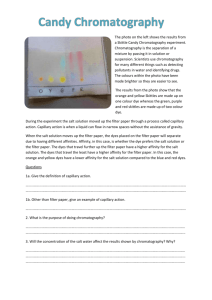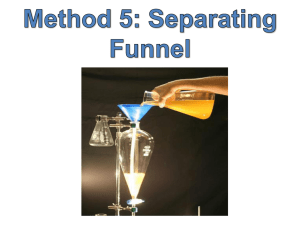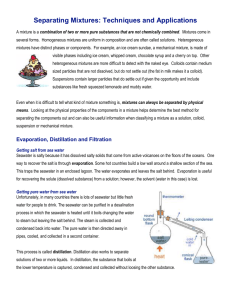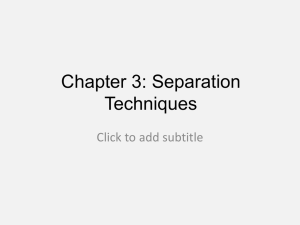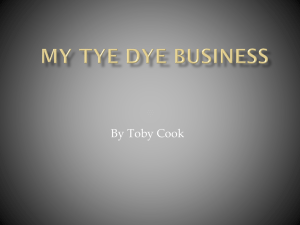Lab report #1 - WordPress.com
advertisement
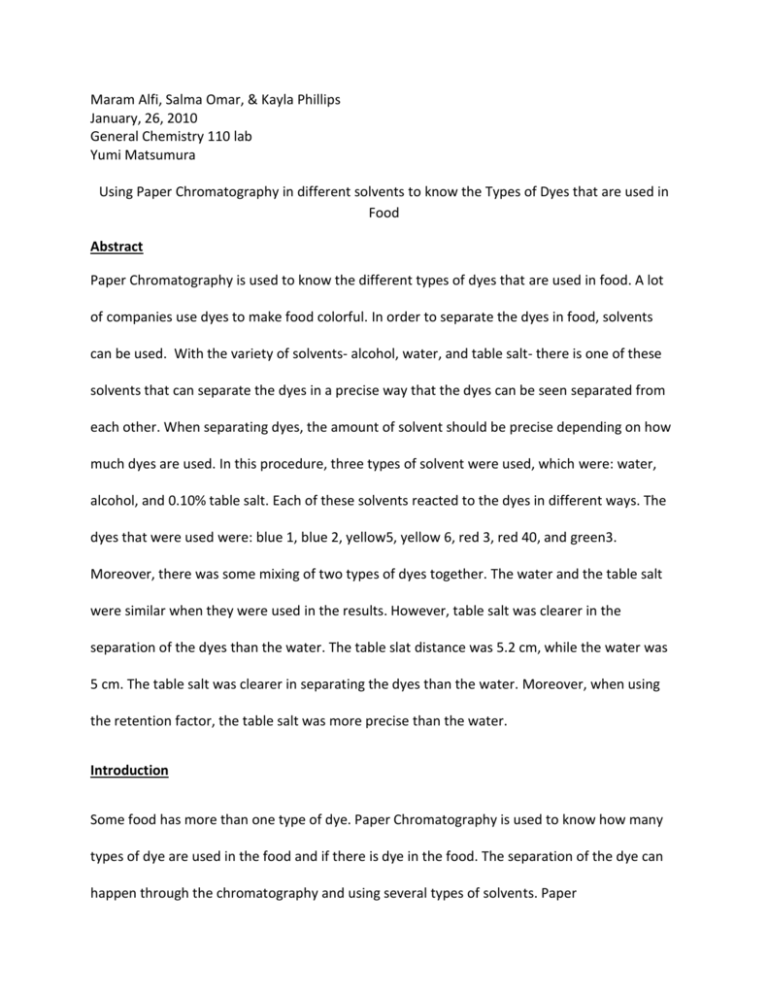
Maram Alfi, Salma Omar, & Kayla Phillips January, 26, 2010 General Chemistry 110 lab Yumi Matsumura Using Paper Chromatography in different solvents to know the Types of Dyes that are used in Food Abstract Paper Chromatography is used to know the different types of dyes that are used in food. A lot of companies use dyes to make food colorful. In order to separate the dyes in food, solvents can be used. With the variety of solvents- alcohol, water, and table salt- there is one of these solvents that can separate the dyes in a precise way that the dyes can be seen separated from each other. When separating dyes, the amount of solvent should be precise depending on how much dyes are used. In this procedure, three types of solvent were used, which were: water, alcohol, and 0.10% table salt. Each of these solvents reacted to the dyes in different ways. The dyes that were used were: blue 1, blue 2, yellow5, yellow 6, red 3, red 40, and green3. Moreover, there was some mixing of two types of dyes together. The water and the table salt were similar when they were used in the results. However, table salt was clearer in the separation of the dyes than the water. The table slat distance was 5.2 cm, while the water was 5 cm. The table salt was clearer in separating the dyes than the water. Moreover, when using the retention factor, the table salt was more precise than the water. Introduction Some food has more than one type of dye. Paper Chromatography is used to know how many types of dye are used in the food and if there is dye in the food. The separation of the dye can happen through the chromatography and using several types of solvents. Paper chromatography is used to “separate components to their original parts”. There are two phases in chromatography: stationary phase and mobile phase (Stranz, 2008). The chromatography, with the dyes on it, and after putting the paper in the solvent, the dyes started to be separated. The dyes, which are mixtures, separated to be clearer to see what the two colors were. The paper chromatography helped to identify which dyes were used. The molecule of the paper chromatography attracts the solvent that is used, such as water (Stranz, 2008). When the solvent is attracted to the paper, then the stationary phase occur (Stranz, 2008). As there is the mobile phase and the stationary phase, the following equation explains how there can be equilibrium: component – mobile phase component- stationary phase. (Stranz, 2008). The following equation explains the retention value when for chromatography. Rf= distance traveled by component. The equation shows the value of the equilibrium. The purpose of this equation is to show the how much the solvent is clear in showing the dye and the mixture of unknown dyes. The hypothesis of this equation is to know which of the various solvents, is the best to show the dye in a clear way. Experimental Method The Signature Lab Series was the book that was used to follow the procedure for this experiment. The tools that were used for this experiment were: Beaker, a plate for the dyes, the paper chromatography, toothpicks, dyes, ruler, and a pencil. First, the dyes were on the plate placed by order to know which dye was the one that was used. After that, the paper was prepared with the measures that were required in the book. Using a tooth pick the dye was placed on the paper. After putting the dyes on the paper, the paper was shaped to a cylinder shape and stapled. Using the beakers, every solvent that was being used, was placed in the beaker with specific measurements. The solvents were: water, alcohol, and table salt. Each one of the paper chromatography that has been prepared is placed in each solvent. The paper left in the solvent until it reaches the point that was decided. Results After the solvent took the time to reach the specific point, the paper has been moved from the solvent to the table carefully and left to dry. After the paper is dried, using a ruler, the measurements are being taken. The first solvent that was done is the water. The water took 7 minutes to reach the point that was deiced on the paper. The starting time for the water was 10:38 A.M. and ending time was 10:45 A.M. The water moved 5 cm. Table one FD&C dyes Distance spot moved, cm Rf Blue 1 4.7 cm 0.94 cm Blue 2 4.5 cm 0.9 cm Yellow 5 4.9 cm 0.98 cm Yellow 6 5.0 cm 1 cm Red 3 1.9 cm 0.38 cm Red 40 4.2 cm 0.84 cm Green 3 5.9 cm 1.18 cm Blue 1 4.5 cm 0.9 cm Red 40 5.0 cm 1 cm Blue 1 and Red 40 Blue 1 and Yellow 5 Blue 1 4.1 cm 0.82 cm Yellow 5 5.4 cm 1.08 cm Red 3 2.0 cm 0.4 cm Yellow 6 4.8 cm 0.96 cm Blue 2 4.1 cm 0.82 cm Yellow 5 5.4 cm 1.08 cm Red 3 and Yellow 6 Blue 2 and Yellow 5 The second solvent was the table salt. The table salt took 9 minutes to get to the point that was decided on the paper. The starting time for the table salt was 10:38 A.M. and ending time was 10:47 A.M. The table salt moved 5.2 cm. The table salt was the best solvent out of the two other solvents which were: water and alcohol. The table salt was the one chosen for continuing separating the unknown dyes. Table two FD&C dyes Distance spot moved, cm Rf Blue 1 1.25 cm 0.24 cm Blue 2 .75 cm 0.14 cm Yellow 5 .75 cm 0.14 cm Yellow 6 .65 cm .125 cm Red 3 .25 cm 0.0480 cm Red 40 1.5 cm 0.288 cm Green 3 .5 cm .096 cm Blue 1 1 cm 0.192 cm Red 40 1 cm 0.192 cm 1 cm 0.192 cm .25 cm 0.0480 cm .5 cm 0.096 cm 1.25 cm 0.240 cm Blue 2 1.1 cm 0. 211 cm Yellow 5 .75 cm .14 cm Blue 1 and Red 40 Blue 1 and Yellow 5 Blue 1 Yellow 5 Red 3 and Yellow 6 Red 3 Yellow 6 Blue 2 and Yellow 5 Finally, alcohol took the longest time to reach the specific point on the paper. The starting time for the alcohol was 10:38 A.M. and ending time was 11:35 A.M. The alcohol moved 3.3 cm. Alcohol was the least clear solvent. Table three FD&C dyes Blue 1 Distance spot moved, cm Rf .5 cm 0.151 cm Blue 2 .5 cm 0.151 cm Yellow 5 .75 cm 0.22cm Yellow 6 .25cm .075 cm Red 3 .1 cm 0.030 cm Red 40 .5 cm 0.151 cm Green 3 .3 cm .090 cm Blue 1 .5 cm 0.151 cm Red 40 .5 cm 0.151 cm Blue 1 .6 cm 0.181 cm Yellow 5 .6 cm 0.181 cm Red 3 .1 cm 0.030 cm Yellow 6 .5 cm 0.151 cm Blue 2 .7 cm 0. 212 cm Yellow 5 .4 cm 0.121 cm Blue 1 and Red 40 Blue 1 and Yellow 5 Red 3 and Yellow 6 Blue 2 and Yellow 5 Discussion The final result of the solvents was surprising. Mostly, water was the most aspect that was moving faster than the other solvents. However, the table salt was the clearest solvent to show the dyes. At the beginning of the paper chromatography, the water was the fastest solvent; however, the table salt was the clearest solvent. Especially after calculating the Rf value for both the water and the table salt. The table salt was more specific than the water. There were huge difference between the water and the alcohol. Also, there were huge difference between the table salt and alcohol. When looking at the distance for every solvent, the solvent that went further was the best solvent to continue with. When looking at the water and table salt results, both of the water and the table salt were really close to each other. When looking at table one “the water table” and table two “the table salt table”, red 3 Rf value had close results in water and table salt. In water column number five was 0.38 cm and in table salt it was 0.48 cm. When calculating the Rf value, there were some mistakes, such as using the wrong columns in the data sheet, Which gave the wrong results. Reference Stranz, M. (2008). Signature Labs Series. Chem 110.
